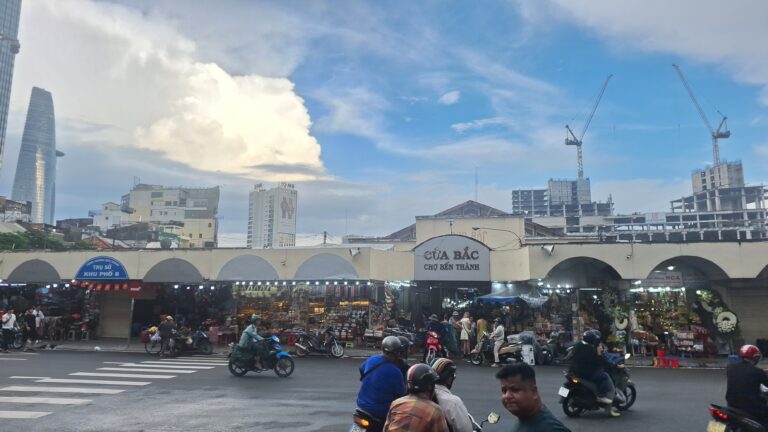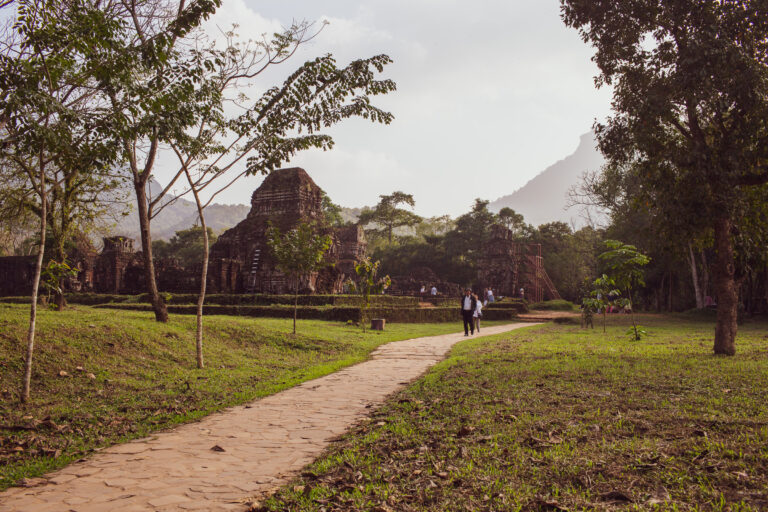
Home > Blog > Destinations > Vietnam’s DMZ: History and Motorbike Routes
Vietnam’s DMZ: History and Motorbike Routes
Share:
- Published:
- Updated: 20/01/25

Vietnam’s demilitarized zone or DMZ is a popular motorbike adventure destination in Vietnam, and for good reason. Not only does it boast some fascinating historical sites, but it also features impressive scenery running from coast to mountain, and fun roads to boot. We’re always happy to visit this region. Whether you’re going through this region simply as a solo tour or part of a much larger Vietnam motorbike tour, it’s well worth spending a day or two here. Below, we’ll cover the background of the area, some of our favorite sites, and explore places to stay.
Table of Contents
Vietnam DMZ Background and History
The DMZ in Vietnam was a strip of land stretching ostensibly along the 17th parallel in Quang Tri province. In reality, the DMZ followed the Ben Hai river from near the border of Laos to the coast along a thin strip of land. The five kilometers of either side of the DMZ was the areas meant to be demilitarized.
Vietnam’s DMZ was created from a combination of geopolitical events. Most importantly, the defeat of the French by the Viet Minh, who subsequently took control of north Vietnam, led to the French relinquishing power in the country. Vietnam was split into two at the Geneva Convention in July 1954, with the Viet Minh occupying North Vietnam and the State of Vietnam in control of the south.
Democratic elections, under UN supervision, were meant to have taken place in July 1956 to determine the future government of the country. Had these elections taken place as intended, the odds are very high that Ho Chi Minh would have won and the country would have been unified under his leadership.
The State of Vietnam and the United States balked at the prospect of these elections, however, so they never took place. Instead, the country would remain divided for almost another two decades until the end of the war that followed.
The DMZ represented the dividing line between North and South Vietnam, and consequently saw some of the fiercest fightings of the war. With the victory of the North, the DMZ became geopolitically irrelevant.
Vietnam DMZ Highlights
Although plenty of historically relevant sites have since been plowed under or otherwise fallen into disrepair, the area still boasts some highlights that are well worth visiting. Those with a keen interest in military history or with a personal attachment to the area would find plenty of interest here.
Vinh Moc Tunnels
The Vinh Moc tunnels certainly fit that description. Vinh Moc village is several kilometers north of the Ben Hai river on the coast. It was a crucial supply depot for the North Vietnamese through which they supplied their compatriots south of Vietnam of the DMZ. Supplies were often shipped around the DMZ by boat, bypassing defenses.
The US and the Army of the Republic of Vietnam (ARVN) were aware of this supply depot, and began consistently bombing it. In response, rather than leave, the entire village was moved underground into a series of tunnels ten meters deep. The US further found out about this, and developed tunnel penetrating bombs, which they continued to drop on the village. Consequently, the village was further deepened to 30 meters.
The entire village remained underground for the duration of the war, and at the end a total of two kilometers of tunnels made up the town and the supply depot. Despite heavy bombing, the village persisted with minimal losses and remained an important supply depot until the end of the war.
How it is Today
These days, the tunnels are maintained as a tourist facility. You can find a local guide free of charge who can explain the history to you and take you on a tour. Those on the larger side or with unreliable joints will be pleased to note that the tunnels are large enough to walk through rather than crawl. Visiting these tunnels is an absolute must on any DMZ adventure.
The area is now known for its rubber and pepper plantations as well as relatively unspoiled beaches. Several small beaches are within just a few hundred meters of Vinh Moc, while the much longer and beautiful beach of Cua Viet stretches for kilometers on the south side of the Ben Hai river.
Hien Luong Bridge
The Hien Luong Bridge is another valuable stop on any DMZ adventure ride in Vietnam. Just several kilometers from the coast, it crosses the Ben Hai river at the village of Hien Luong. Crucially, it represented the dividing line between North and South Vietnam. Consequently, it was closed towards the end of the war. Loudspeakers on either side played propaganda at each other in a form of psychological warfare.
Today, you can walk across the bridge and see the colors that indicate the historical split of the country. There’s a museum on the north bank with information about the bridge and its history that’s worth checking out.
Additionally, there’s a replica of the UN headquarters that was built to monitor the area. Unsurprisingly, the original building suffered heavy damage during the war and was abandoned. The replica, however, gives a good indication of what the original looked like and is worth a quick stop.
None of these activities takes terribly long, so they’re a worthwhile stop to see an important piece of history.
Truong Son National Martyr’s Cemetery
Perhaps a half hour ride west of Hien Luong bridge is the Truong Son National Martyr’s Cemetery. The cemetery was created to commemorate soldiers who had died on the Ho Chi Minh Trail, the vital north-south supply route that was key in the North’s victory. Here, 50 provinces chose 200 soldiers each to be represented as martyrs for the country. Consequently, there are 10,000 graves.
Although the cemetery is a peaceful and quiet place, it serves as a reminder of the sacrifices made in war and so naturally it has a somber feel to it. It’s well worth a stop and serves to underscore the value and fragility of peace.
The Rockpile
Roughly an hour’s drive southwest of Truong Son Cemetery is a hill known as the Rockpile. During the war, it served as an important observation post for US Marines stationed in the area. Because it rises high above the surrounding area at the convergence of several valleys, it was a strategic asset that eventually forced the North Vietnamese Army to move its supply routes further to the west.
Although these days it’s little more than one hill among many, those with a keen eye for history will be pleased to see this once-important geographic feature. It’s covered with greenery nowadays and outwardly shows little sign that it was ever the site of fighting.
Camp Carroll
To the east of the Rockpile is Camp Carroll, a large and vitally important US artillery base during the war. However, when describing Camp Carroll now, the word “was” is more applicable since Camp Carroll is no longer there. Besides a relatively minor monument denoting the entrance of the camp, the entire area is now a pepper plantation — representing as close to a literal ‘swords to plowshares’ scenario as one could imagine.
Not just Camp Carroll, but plenty of other wartime relics have been plowed under. Much of this area is valuable farmland. Consequently, many locals, as well as the government, would prefer to have it be productive land rather than set aside as an open-air museum for a war that many are happy to put behind them.
Khe Sanh
Near the Laos border, south of the DMZ is the town of Khe Sanh, along with the remnants of Khe Sanh combat base. Khe Sanh saw the longest battle of the war, with marines under siege for many months. During this fight, President Lyndon Baines Johnson famously remarked he “Didn’t want any damn Dien Bien Phu,” referencing the crushing defeat the French suffered in the famous 1954 siege. Americans withdrew after months of fierce fighting, scrapping much of the base in the process.
To the north of town, the remains of Ta Con airbase can still be found, complete with a museum. Here you’ll also see helicopters, a C130 gunship, and other abandoned or captured military equipment.
Routes in the DMZ Vietnam
Because the country is so narrow and the landscape changes so quickly here, there’s quite a bit of variation in the roads in this area. Towards the flat lands along the coast you’ll find some small villages with relatively peaceful coastal roads. Head inland and the hills rapidly rise, and you’ll find yourself in much more remote and rugged terrain, complete with mountains and jungles. One of the best things about this area is that you’re able to see a dramatic shift in terrain so quickly.
A typical day could look something like this:
First a drive from Dong Ha to Vinh Moc.
Then:
a quick jaunt from Vinh Moc to Hien Luong bridge, followed by Truong Son Cemetery.
Then:
from Truong Son Cemetery to the Rockpile.
Finally from the Rockpile to Khe Sanh, where you can either choose to call it a day or pay a visit to the Khe Sanh Combat Base if you have a chance.
Along the way at any of these stops you may run into a middle-aged local man who sells scraps he’s found using his metal detector. He may be persistent, but do recall that selling these scraps is his only livelihood.
The driving gets more fun and twisty the further west you go — especially once you get west of Da Krong where, incidentally, the battle of Khe Sanh began. When you’re into the hills heading towards Laos, you can expect the iconic Vietnamese mountain driving feel of twists, turns, hills, and jungles.
If you carry on west of Khe Sanh you’ll get to the border town of Lao Bao, where an international checkpoint would allow you to cross into Laos. Lao Bao itself is a sleepy border town but is surprisingly wealthy, as evidenced by many new houses and buildings. Fresh buffalo meat is popular in town, so if you’re up for trying another variety of bovine you can make your way there for dinner.
The Ho Chi Minh Trail West
Heading north from Khe Sanh is one of our favorite stretches of road in the country: The Ho Chi Minh Trail West. This stretch of road carries you All the way from Khe Sanh to Phong Nha / Ke Bang National Park in Quang Binh province, and we can’t recommend it enough. You can check out our full article on it Here.
Accommodation Options near the DMZ in Vietnam
Generally speaking, most people touring the DMZ in Vietnam choose to either stay in the town of Dong Ha, the capital of Quang Tri province, or in Khe Sanh on the western end of the DMZ. Either of these is quite acceptable options as you’ll find anything you need in each town: acceptable bedding, food, coffee, and a place to have a beer if you wish.
The town of Dong Ha has loads of hotels and Nha Nghi (smaller guest houses) to choose from, though we generally don’t stay there on our tours. If you’re passing through and need to stay, the Saigon Dong Ha and Muong Thanh are the two best hotels in town, though they’re both located on the main highway. There aren’t many places in the world you can stay in a 4-star hotel for $30 or less, so consider that a feature if you choose to stay in Dong Ha.
In Khe Sanh, we have two hotel recommendations: Khanh Phuong and Green Hotel, the latter of which is easy to find due to the fact that it’s, well, big and green. Additionally, if you’d like to see the pinnacle of Vietnamese luxury a few decades ago, the Thai Ninh hotel could be an interesting stop, if not the best maintained. None of the above hotels could be considered luxurious, but you’ll have a bed, shower, and air-con. Best of all, they ride the line between affordable and “How is this so cheap?”
Alternatively, you could choose to stay along the dozens-of-kilometers-long-and-almost-empty Cua Viet beach. The beach itself is beautiful and, as mentioned, nearly deserted. Hotels are few, but there are indeed some: Hoang Anh, Tung Viet, and Minh Tien towards the south end, and Phat Tai just near the mouth of the Ben Hai river.
Onyabike Adventures’ Thoughts
As part of a larger Vietnam motorbike adventure or as a standalone DMZ tour, visiting this part of Vietnam is both enlightening and fun. You don’t have to be a history buff to appreciate it: the drive itself is fun in its own right. History buffs, however, will likely get an extra kick out of the area due to its pivotal role in a major conflict. And anyone will appreciate how quickly the country has moved on and is prospering now.
We’re happy to Include this area in several of our tours and our geeked-out, knowledgeable guides will be thrilled to answer any of your questions along the ride. Because it’s not just where you go, but also what you know that makes a trip fun.
Related Posts
Recent Posts






